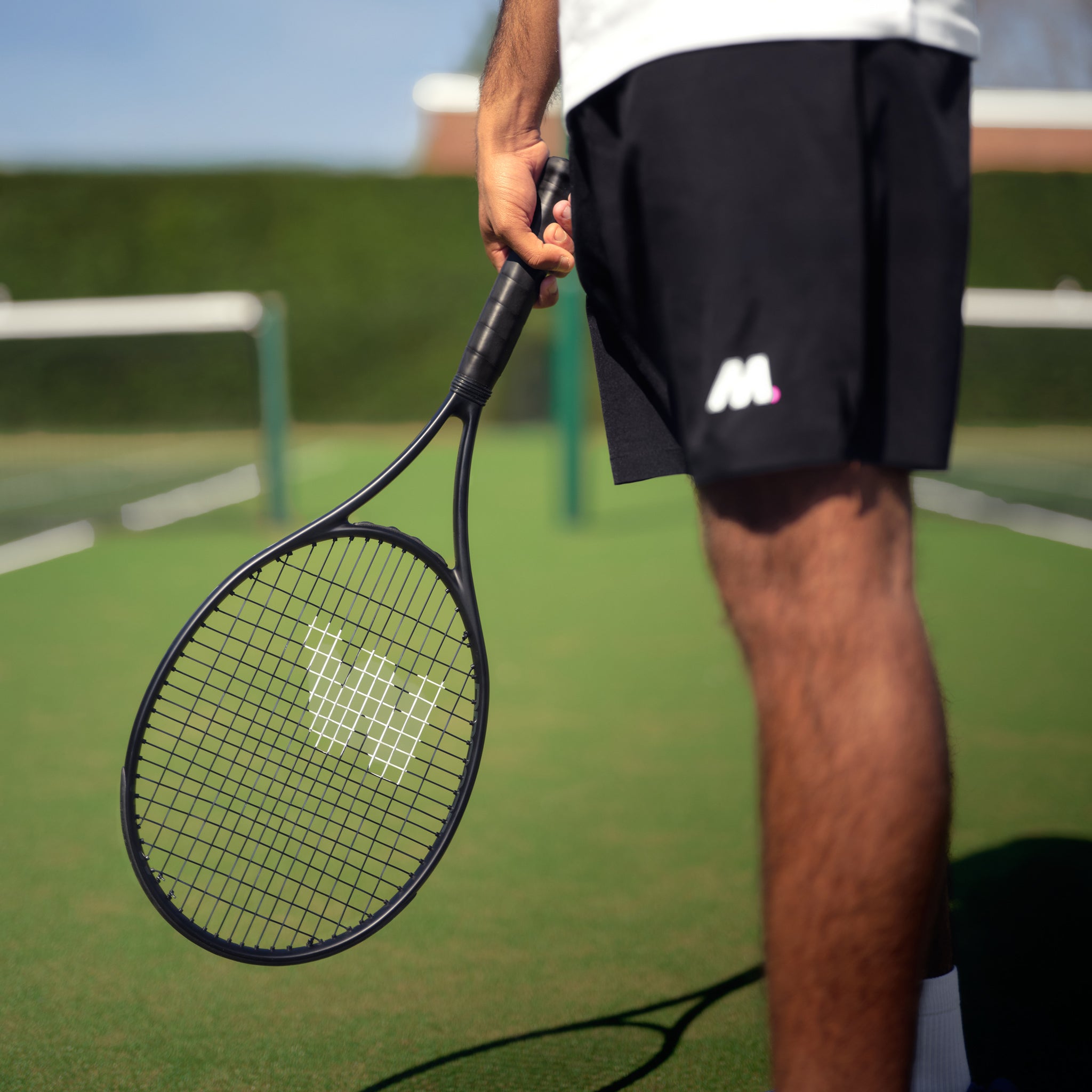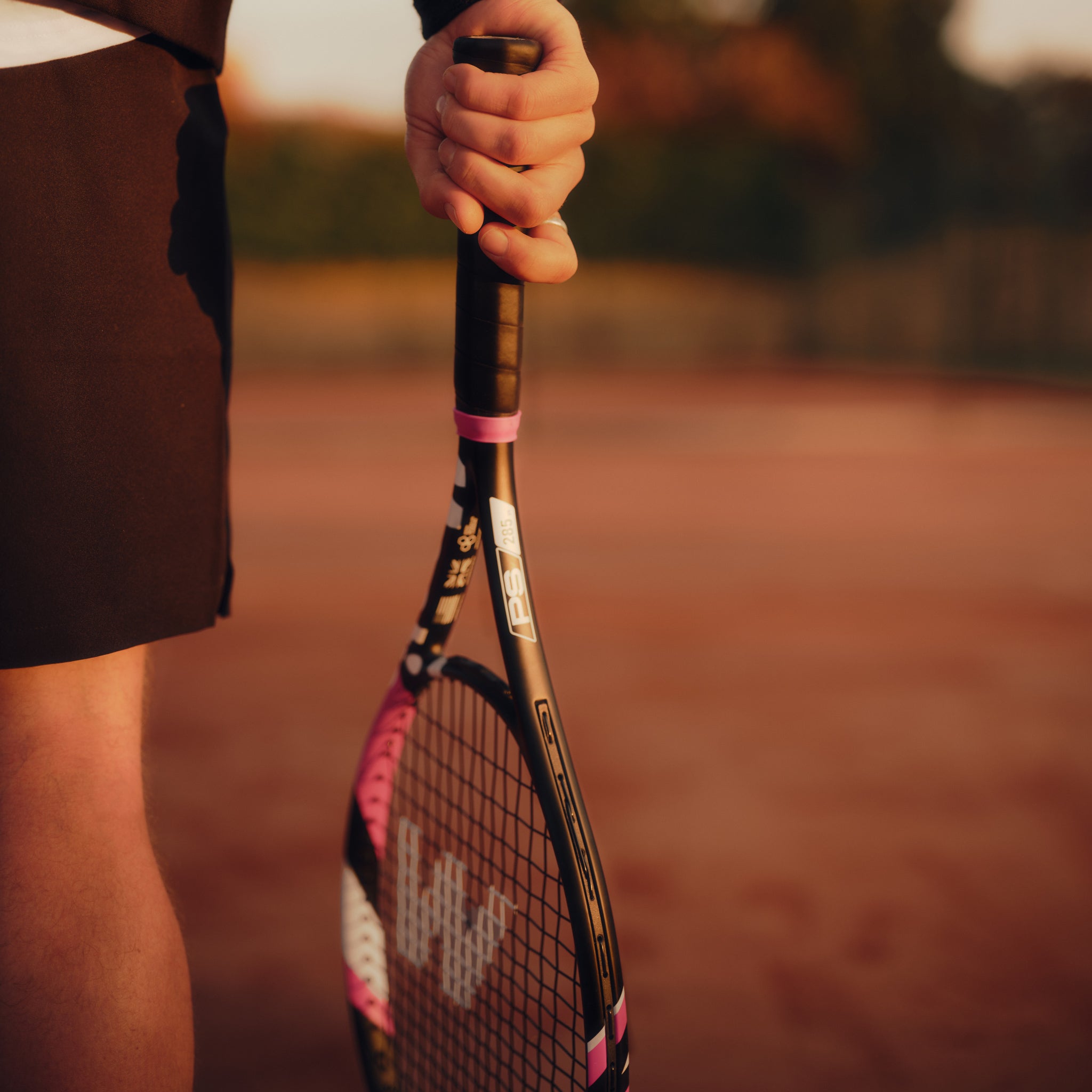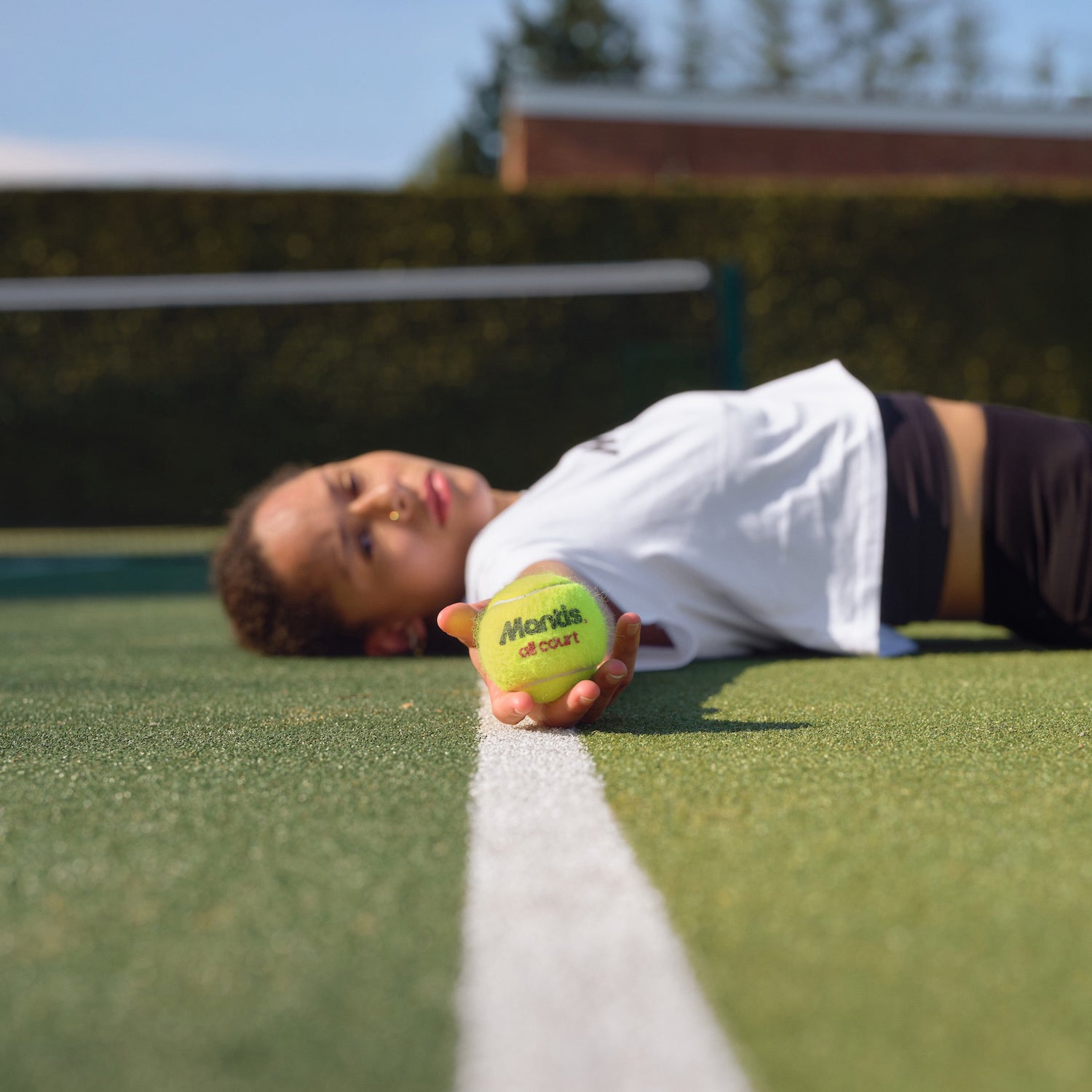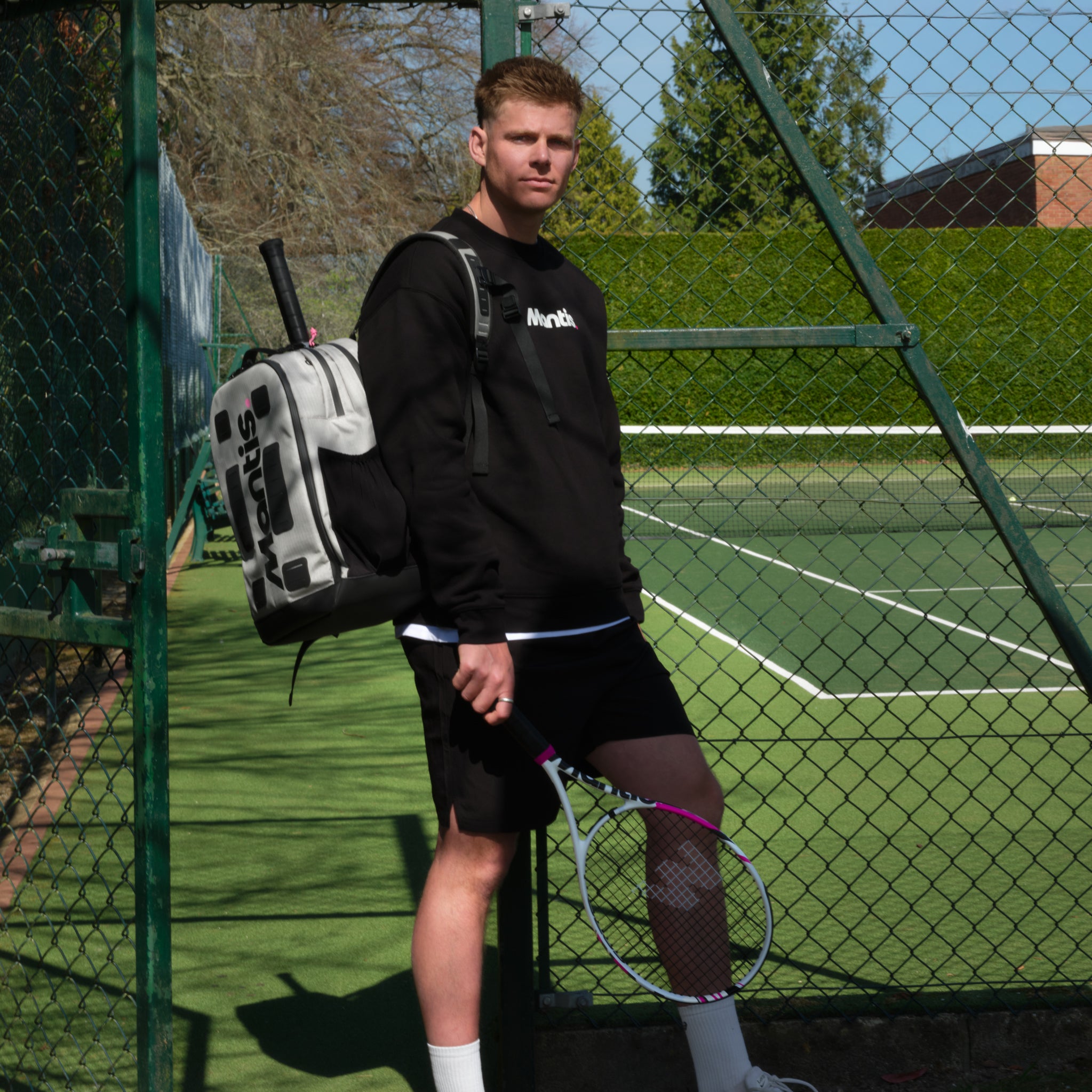
So, you're ready to learn how to play tennis? It’s a fantastic decision. At Mantis, we believe tennis is one of those sports that offers a brilliant workout, a serious competitive challenge, and a lifetime of fun all rolled into one. For a great overview, check out our guide on tennis for beginners.
The path from beginner to confident player is all about mastering the fundamentals. It really comes down to a few key areas: getting to know the court, picking the right gear for your game, learning how to hold the racquet, and developing your essential strokes. With a bit of practice and the right guidance, you’ll be ready for your first match in no time.
Your Journey to the Tennis Court Starts Here
Welcome to our definitive guide for anyone picking up a racquet for the first time. Here at Mantis, we're passionate about helping new players build a solid foundation. Think of this as your roadmap, designed to take you from that first slightly awkward swing to playing with genuine confidence.
If you want a quick primer before we get into the details, our guide on tennis for beginners is the perfect place to start.
Our goal is to break down the essentials in a way that makes sense. We'll skip the confusing jargon and focus on practical, actionable advice that you can take straight to the court and see immediate results.
What to Expect
We've structured this guide to build your skills logically, starting from the ground up. This way, you won't miss any of the crucial steps that great players rely on.
- Court and Equipment: First things first, we'll cover the layout of your new playground and the gear you actually need to get started.
- Grips and Stances: Next, you'll discover the different ways to hold the racquet and how to position your body to generate power and maintain control.
- Core Strokes: Then it's time for the fun stuff – learning the mechanics of the forehand, backhand, volley, and the all-important serve.
At Mantis, our mission is to make tennis accessible to everyone. We want to provide a complete learning experience, guiding you every step of the way with expert insights and practical tips. We’re excited to help you get started.
Understanding the Court and Essential Equipment
Before you even think about hitting your first ball, it pays to get familiar with your surroundings and your gear. At Mantis, we always advise that getting comfortable with the layout of the court is a great first step. Walking onto a tennis court for the first time can feel a bit overwhelming with all those lines, but once you know what they mean, it starts to feel like a second home. The same goes for your equipment; having the right racket, shoes, and balls not only helps you play better but also keeps you safe and comfortable, making the whole experience much more enjoyable.
The court itself is a rectangle split right down the middle by a net, with a whole bunch of lines that dictate where the ball is allowed to go. These aren't just random markings; they're the rules of the road for every serve and rally. Getting a handle on these boundaries is the very first step in understanding the game's strategy.
Decoding the Tennis Court Layout
Think of the court as your map for every point. The most important lines to get to grips with are the baseline, the sidelines, and the service lines. The baseline is that big line at the very back of the court, marking the end of the playing area.
Then you have the sidelines, which define the width. For a one-on-one singles match, you’ll use the inner sidelines. When you’re playing doubles, the court expands to include the outer lines, often called the "tramlines." Lastly, the service lines form two boxes on each side near the net – these are the targets you need to hit when you serve.
A standard tennis court is 78 feet long and 36 feet wide for doubles. Knowing this gives you a real appreciation for the ground players have to cover during a fast-paced rally.
Choosing Your First Tennis Racket
Picking out your first racket can seem complicated, but as a beginner, your focus should be on comfort and control, not raw power. At Mantis, our philosophy is that a racket should feel like a natural extension of your arm, not some clunky piece of equipment. When you’re starting, concentrate on three things:
- Head Size: Go for a racket with a larger head, somewhere around 100-110 square inches. This gives you a bigger "sweet spot," which means the racket is more forgiving when you don't hit the ball perfectly in the centre.
- Weight: A lighter racket, perhaps 255-285 grams, is much easier to swing. This lets you focus on getting your technique right without your arm feeling like lead after ten minutes.
- Grip Size: This is absolutely vital. The wrong grip size can be uncomfortable and even lead to injuries. A quick way to check is to grip the racket and see if you can slide the index finger of your other hand snugly between your palm and your fingertips.
The Importance of Proper Footwear and Tennis Balls
It might be tempting to just grab your running shoes, but we believe tennis-specific shoes are a must. They’re built to support the sharp, sideways movements that are so common in tennis, giving you stability that other trainers just can’t offer. A good pair will protect your ankles and knees from the constant stopping and starting.
And it’s not just the shoes – the balls matter, too. Not all tennis balls are the same. When you're new to the game, look for pressureless or lower-compression balls. They don't bounce as high or fly as fast, which gives you that extra split second to get in position and hit a clean shot. It's a small change that makes a massive difference in helping you build rhythm and confidence.
Mastering Fundamental Grips and Stances
In tennis, your grip is your direct line to the racket. It's the foundation for every single shot you'll ever hit. Think of it as the steering wheel – a solid grip gives you control, helps you generate power, and, just as importantly, can prevent injuries down the line. We really can't stress this enough: getting your grip right from the very beginning is crucial. For more details, explore our guide on how to grip a tennis racket.
Once your hands are set, your feet need to be in the right place, too. A solid stance gives you the stable, balanced base you need to hit powerful, consistent shots time and time again.
To really get to grips with how to hold the racket, it helps to think of the handle as an octagon with eight sides, or 'bevels'. For a much deeper dive into this, we've put together a detailed guide on how to grip a tennis racket that's well worth a read. Nail these two elements—grip and stance—and you'll have the core mechanics to hit with purpose and move around the court like you belong there.
A powerful serve isn't just one thing; it's a whole chain of coordinated movements, from the height of your toss to racket speed and a complete follow-through.
The Essential Tennis Grips
There are quite a few ways to hold a racket, but when you're just starting out, it's best to focus on three main grips. Each one has a different job and is better for certain shots. Learning to switch between them smoothly is a skill that will pay off massively.
Here's a quick look at the grips you'll need to know.
Essential Tennis Grips and Their Uses
| Grip Name | How to Hold | Primary Use |
|---|---|---|
| Continental | Like you're shaking hands with the racket handle. | Serves, volleys, overheads, and slice shots. Your go-to 'utility' grip. |
| Eastern | Place your palm flat against the strings and slide down to the handle. | Great for beginners hitting flatter forehands. A good mix of power and control. |
| Western | With the racket face on the ground, pick it up by the handle. | Hitting forehands with heavy topspin. Allows you to get under the ball. |
Getting familiar with these grips will give you the versatility you need to handle whatever shot comes your way.
-
The Continental grip is often called the "hammer grip." It's incredibly versatile, making it the one you'll use for serves, volleys, overheads, and slices. The only downside is that it can be a bit tricky for generating heavy topspin on your groundstrokes.
-
Next up is the Eastern grip, which is a fantastic starting point for learning your forehand. It gives you a nice, comfortable balance of power and control and makes it easier to hit the ball right in the "sweet spot." It's perfect for developing a consistent, flat forehand drive.
-
Finally, the Western grip is what you'll see from players who love to hit with heavy topspin. By getting your hand further underneath the handle, you can really brush up the back of the ball aggressively. It’s popular with the pros, but honestly, it can be a bit challenging to get the hang of when you're new to the game.
Our advice? Start with the Eastern grip for your forehand and the Continental for just about everything else. As you get more confident, you can start experimenting with other grips to see what feels right for your style of play.
Finding Your Ideal Stance on the Court
Alright, so your grip is sorted. Now, let's talk about your stance. The way you position your feet and body before and during a shot dictates your balance, power, and how quickly you can get ready for the next ball. A sloppy stance leads to off-balance shots and makes it a real struggle to move efficiently.
The foundation for everything is the ready position. This is your neutral, athletic stance while you're waiting for your opponent to hit. Get on the balls of your feet, bend your knees, keep your weight slightly forward, and hold the racket out in front of you. This posture primes you to move in any direction—left, right, forward, or back—in a split second.
Open vs Closed Stances
From that ready position, you’ll move into different stances for different shots. The two most common are the open and closed stances, and they each have their own advantages.
-
The Open Stance: Here, your body faces the net more directly. It’s fantastic for hitting powerful forehands and allows for a quicker recovery because you don't have to rotate your body as much. You'll see a lot of modern players use an open stance to handle fast-paced balls, especially on the return of serve.
-
The Closed Stance: This is the more traditional stance, where you turn your body sideways to the net. It encourages a full shoulder turn, which helps generate more power and control, especially on your backhand. It's a brilliant stance for learning proper swing mechanics and is often used for approach shots.
Knowing when to use each stance is key. For instance, if you're pulled way out wide by an opponent's shot, an open stance helps you hit the ball while staying balanced. On the other hand, when you have a bit more time to set up in the middle of the court, a closed stance will help you drive through the ball with maximum power. Mastering both will make you a much more adaptable and dangerous player.
Developing Your Core Tennis Strokes
Once you’ve got a feel for your grip and stance, it’s time to start building your arsenal of shots. The strokes are the heart of tennis, turning those fundamentals into a dynamic, effective game.## Developing Your Core Tennis Strokes
Once you’ve got a feel for your grip and stance, it’s time to start building your arsenal of shots. The strokes are the heart of tennis, turning those fundamentals into a dynamic, effective game. Here at Mantis, we find that really understanding the mechanics of each shot takes the mystery out of learning, helping you build consistency and confidence every time you step on the court. Our guide on how to grip a tennis racket is a great resource for this.
Let’s dive into the four essential strokes every player needs. We’ll break down the forehand, backhand, volley, and serve into clear, manageable parts, from the initial preparation right through to the follow-through.
The Reliable Forehand Groundstroke
For most people, the forehand feels like the most natural and powerful shot they have. It’s the one you hit on your dominant side after the ball has bounced, and it quickly becomes the backbone of your baseline game. A great forehand is all about fluid rotation and solid timing.
The whole motion kicks off with a 'unit turn', where you rotate your shoulders and hips away from the ball to prepare the racket. As the ball makes its way to you, your swing should start low and travel upwards, brushing up the back of the ball to create that lovely topspin that makes it dip into the court.
You’re aiming to make contact out in front of your body, ideally around waist height. After you’ve struck the ball, let the swing continue naturally across your body in a relaxed follow-through, often finishing up over your opposite shoulder.
Key Takeaway: The power in your forehand comes from your body's rotation, not just your arm. Focus on turning your hips and shoulders during the preparation phase to generate effortless power and control.
Mastering the Backhand Two Ways
The backhand is the perfect counterpart to your forehand, hit on your non-dominant side. We have seen many beginners struggle with it at first, but with a bit of practice, it can become just as dependable as any other shot. There are two main ways to hit it: with two hands or with one.
The Two-Handed Backhand
This is easily the most common backhand you’ll see on courts today, from local clubs to the pro tour. Why? It offers fantastic stability and control. Your dominant hand usually takes a Continental grip, and your non-dominant hand sits above it in an Eastern forehand grip.
This setup lets your non-dominant side do most of the work, almost like you’re hitting a forehand with your other arm. The swing path is similar to the forehand—low to high—and having two hands on the racket makes it much easier to handle high bouncing balls and powerful serves.
The One-Handed Backhand
Often seen as the more elegant shot, the one-handed backhand gives you a bit more reach. Players typically use an Eastern backhand grip for this, but be warned: it requires more wrist and forearm strength to keep the racket face steady through impact.
While it can be trickier to get the hang of, the one-hander makes slicing the ball feel incredibly natural and helps you stretch for those wide shots. Many players find the fluid, sweeping motion hugely satisfying once they’ve put in the hours to develop the strength and timing.
For anyone just starting to learn how to play tennis, we almost always suggest beginning with the two-handed backhand. It’s just more stable. As your game improves, you can always experiment with the one-hander later on to see if it suits your personal style.
Taking Control at the Net with the Volley
A volley is a shot you hit before the ball bounces, usually when you’re up close to the net. It’s an aggressive, attacking shot meant to end the point quickly. Forget what you learned with groundstrokes; the volley isn’t a full swing. It’s a short, crisp, punching motion.
The secret to a good volley is quick preparation and a very short backswing. Use a Continental grip, keep the racket head up and in front of you, and step forward into the shot to put your body weight behind it. The idea is to meet the ball out in front, essentially blocking it with a firm wrist into the open court.
Effective volleys demand sharp reflexes and decisive footwork. Try these simple drills to build that muscle memory:
- Wall Volleys: Stand a few feet from a practice wall and try to hit consecutive volleys without the ball bouncing. It’s brilliant for sharpening your reaction time and control.
- Partner Volley Rally: With a partner, stand on opposite service lines and have a rally using only volleys. This really helps you develop a soft touch and the quick adjustments you need at the net.
Finding a place to practise these strokes is easier than you might think. The infrastructure for tennis in the UK is fantastic, with over 16,800 tennis courts available across the country. This network fuels a strong tennis culture, underscored by the massive popularity of events like Wimbledon, which pulled in over 50 million streams in a recent year. With around 8.4% of children in England already involved in the sport, it's clear the UK's thriving tennis scene offers plenty of opportunities to get involved.
The All-Important Serve
The serve is, without a doubt, the most important shot in tennis. It’s the only one where you have complete control over the situation. A great serve can win you points outright (an ace!) or immediately force your opponent onto the back foot. It's also the most complex motion, blending a toss, a swing, and pinpoint timing into one fluid action.
A good serve can be broken down into four key phases:
- Preparation and Grip: Start with a Continental grip. Stand behind the baseline, feet about shoulder-width apart, angled slightly towards the net post on the opposite side.
- The Toss: This is probably the most crucial part. A consistent toss is everything. You want to throw the ball to the same spot every time—slightly in front of you and into the court—so you can hit it right at the peak of its height.
- The Swing Path: As you toss the ball, your racket drops down behind your back (the "racket drop"). From this position, you swing up and forward, pronating your forearm as you make contact to generate power and spin.
- Follow-Through: After hitting the ball, your arm and racket should continue across your body, finishing down by your opposite side. This ensures a smooth, powerful motion and helps prevent injury.
Developing a consistent serve takes patience and lots of repetition. Our advice is to practise each part separately—just the toss, then just the swing—before you try to put it all together. A reliable serve is a true game-changer, giving you a massive head start in every single point.
Getting to Grips with the Rules and How to Keep Score
You can have the most beautiful strokes and the quickest feet on the court, but that’s only half the battle. To really play tennis, you need to speak its language—and that means understanding the quirky scoring system and the fundamental rules of the game. It’s what turns a casual knockabout into a real, competitive match. A great starting point for this is our guide to tennis for beginners.
And it seems more people than ever are getting into the game. Tennis is booming across the UK right now, with 5.6 million adults picking up a racket each year and 2.6 million playing monthly. With organisations like the LTA investing heavily in courts and coaching, knowing the basics has never been more important. If you're curious about this growth, you can learn more about the recent achievements in UK tennis.
Making Sense of the Tennis Scoring System
Let’s be honest, tennis scoring can look a bit odd at first. You're not counting 1, 2, 3. Instead, you'll hear umpires call out "love," "15," and "deuce." It might seem confusing, but once you get the hang of it, you'll see it has a simple, layered logic. You're always working your way up from points to games, then sets, and finally, the match.
Here's how it all fits together:
- Points: These are the smallest building blocks. You win one every time your opponent fails to return your shot into the court.
- Games: To win a game, you need to win at least four points. Crucially, you must win by a margin of at least two.
- Sets: A set is simply a race to win six games. And just like with points, you need to win the set by at least two clear games (e.g., 6-4).
- Match: Most matches are the best of three sets. The first player to win two sets takes the victory.
So, what about that "15, 30, 40" business? That's the score within a single game. The first point you win is called 15, the second is 30, and the third is 40. If you win the next point, and your opponent isn't also on 40, the game is yours.
What Happens at Deuce and Advantage?
This is where that "win by two" rule really kicks in. If the score in a game gets to 40-40, it's called deuce. From here, you have to win two points in a row to close out the game.
Winning the first point after deuce puts you at Advantage. If you're the server, you might hear this called "Ad-In." If you're the receiver, it's "Ad-Out." Win the very next point, and you've won the game. But if your opponent wins it, the score snaps right back to deuce. You then have to play on until one player finally clinches those two consecutive points.
The Must-Know Rules of Play
Beyond scoring, a few key rules dictate the flow of every single rally. Knowing them will stop you from giving away cheap points and ensure you're playing fairly, whether it's a friendly hit or a club match.
Serving Rules and Faults
Every point starts with a serve, and it has some strict regulations. You have to stand behind the baseline and hit the ball over the net into the service box that's diagonally opposite you. A mistake here is called a fault.
- First Serve: You always get two chances to get your serve in.
- Second Serve: If you miss the first one (by hitting it into the net or out of the box), you get a second go.
- Double Fault: Mess up the second serve as well? That's a double fault, and you automatically lose the point.
Another thing to watch for is a foot fault. This happens if you step on or over the baseline before your racket makes contact with the ball.
Is the Ball In or Out?
This is probably the biggest source of friendly disagreements in matches without an umpire. The rule itself is simple: if any part of the ball touches any part of the line, it’s 'in'. The lines are considered part of the court. A ball is only 'out' if it lands completely clear of the line.
In social tennis, it all comes down to good sportsmanship. The unwritten rule is that you trust your opponent's calls on their side of the court, and you make clear, honest calls on yours. If you're ever in doubt, the fairest thing to do is give your opponent the benefit of the doubt.
Drills to Keep You Improving
Getting the basics down is one thing, but the real secret to becoming a better player is all about smart, consistent practice. Here at Mantis, we're big believers that how you practise is just as crucial as how often you get on court. To genuinely learn how to play tennis, you need to move beyond just hitting balls back and forth. You need drills that hone specific skills, lock in muscle memory, and get you ready for the pressure of a real match. For additional tips, our tennis for beginners guide is an excellent resource.
This is where you shift from just playing to actually training. Every session, whether you're with a partner or up against a practice wall, is a golden opportunity to fine-tune your game.
Drills That Really Sharpen Your Skills
A great practice session is all about breaking your game down into manageable chunks. Before you even think about hitting with more power, your first goal should always be consistency. You're building a reliable foundation that won’t desert you when the pressure is on.
Here are a few of our favourite drills to get you started:
- Cross-Court Rally: This one’s a classic for a reason. Get on the baseline with a partner and start a cross-court rally (your forehand to their forehand). The aim? Keep it going as long as possible. Count the number of successful shots and try to beat your personal best. It's a fantastic drill for improving your footwork, timing, and grooving that repeatable swing.
- Serve and Return Scenarios: Don't just mindlessly hit serves. Place a few targets, like cones or even a towel, in the service boxes and work on hitting your spots. If you've got a partner, get them to return your serves so you can play out that critical first shot after the serve.
- The Wall is Your Best Friend: For solo practice, nothing beats a good old practice wall. Stand close and hit quick-fire volleys to sharpen your reflexes. Then, take a few steps back and work on your groundstrokes, concentrating on keeping a steady rally going.
How to Make Every Practice Count
Just showing up and going through the motions won't lead to much improvement. To see real progress, you need to walk onto the court with a clear goal for every session. Instead of vaguely planning to "hit for an hour," get specific. Tell yourself, "Today, I'm going to land 70% of my first serves," or "I'm not leaving until I've hit 20 backhands in a row cross-court."
Quality over quantity, always. Ten minutes of deliberate, focused work on one specific shot is far more valuable than an hour of just hitting balls without thinking. Be present in the moment and analyse the technique behind every single ball you hit.
It’s also worth noting that the UK's racket sport scene is booming, with similar games like padel gaining huge popularity. In just one year, over 400,000 people picked up a padel racket, and there are now nearly 900 courts nationwide. This growth, backed by significant LTA investment, means there are more opportunities than ever to stay active and competitive across all racket sports. You can read more about the growth of racket sports to see how the landscape is changing.
Got Questions About Learning Tennis?
When you're just starting out on the court, it’s natural to have a lot of questions. We get it. Feeling confident in the basics is a huge part of enjoying the game, so we’ve put together answers to some of the most common queries we hear from new players.
If you want a full rundown before diving in here, our guide to tennis for beginners is the perfect place to start.
How Long Does It Really Take to Get Good?
This is the big one, isn't it? Everyone's journey is different, but a good rule of thumb is that with consistent practice—say, 2-3 times a week—most beginners can hold a decent rally and play a basic game within a few months.
Making that leap to an intermediate level? That usually takes a year or two of dedicated play, and probably some coaching. The secret isn't hitting the ball as hard as you can; it's patience and locking down solid fundamentals from the very beginning.
Can I Learn How to Play Tennis Without a Coach?
You can definitely pick up the basics on your own, but if you're serious about improving, we can't recommend a coach enough. A professional spots things you can't and teaches you proper technique from the get-go. This is huge, because it helps you avoid those bad habits that are incredibly tough to break later on.
If one-on-one coaching feels like a big step, look into group lessons. They're a brilliant, budget-friendly way to get expert guidance and meet other people who are also just starting out.
What’s the toughest shot to learn? For most new players, it's the serve. It’s a complex, full-body motion that demands coordination, timing, and power all at once. The trick is to break it down into smaller, manageable parts and practise each one relentlessly until it clicks.
At Mantis, we believe your equipment should be as committed to your game as you are. We design performance rackets, balls, and gear for players who want to get better.
See the full collection at https://mantissport.com.








